Google Nexus 5 Review
by Brian Klug on December 5, 2013 8:00 AM EST- Posted in
- Smartphones
- LG
- Android
- Mobile
- Snapdragon 800
- Android 4.4
- Nexus 5
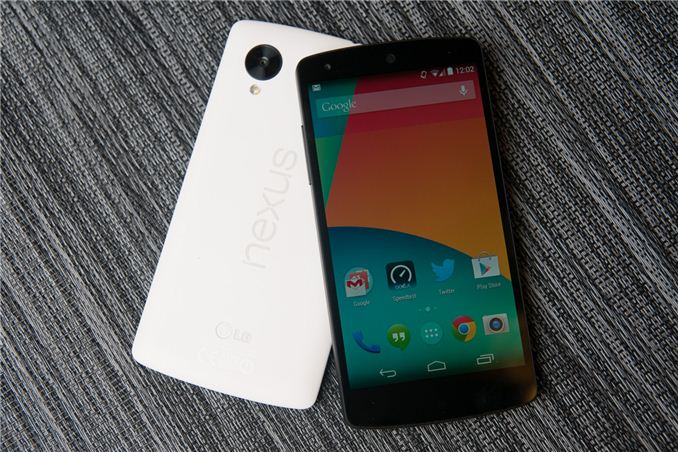
Each year, Google picks a silicon vendor, a hardware partner, and releases a new version of Android running on top of them. The result is a Nexus phone, and for five iterations now that process has repeated, resulting in a smartphone that’s the purest expression of Google’s vision for its mobile platform. Today we’re looking at the Nexus 5.
Nexus 5, as its name makes obvious, is the latest generation of Google’s line of Nexus smartphones, and also is topped by a 5-inch display. While the Nexus program originally started only for smartphones, we’ve seen Google since extend the program to include a 7-inch and 10-inch tablet form factor, as well as a line of accessories. In recent years, we’ve seen Nexus go from being part enthusiast curiosity and development device, to a brand tailored for consumers looking for the latest and greatest the Android platform has to offer at a killer price.
Last generation we saw the Nexus 4, a device that was essentially an LG Optimus G for T-Mobile in different clothing and priced at a competitive price, yet still included the latest and greatest silicon from Qualcomm with APQ8064 (S4 Pro). For Nexus 5, Google has once again gone with hardware partner LG and silicon vendor Qualcomm, this time with a phone that’s somewhat analogous to the LG G2 (but not exactly the same platform) and using the latest and greatest MSM8974 (Snapdragon 800) silicon.
Let’s start with the hardware, since that’s the normal flow for a review. The Nexus 4 bore a lot of superficial similarities to the Optimus G, including a glass back with laser etched design below its surface, the same display, banding, and materials. The Nexus 5 on the other hand doesn’t bear any similarities to the G2, with its buttons on the back, narrow bezel, rounded backside, and glossy plastic. Instead, the Nexus 5’s design borrows much of its industrial design language from the Nexus 7 (2013), with the slightly rounded top and bottom, landscape “nexus” logo on the rear, and large radius curves all around the side. The Nexus 5 and 7 share almost the same shape and profile, and in the case of the black Nexus 5, same rubberized soft touch material on the back and sides. If you scaled down the Nexus 7 design you’d get something which is awfully close to the Nexus 5.
The result is a two-device family that feels like it was made by the same company, and it’s really the first time Google has aligned its industrial design in such a sweeping fashion, in this case even across two different hardware partners. I guess you could make the argument that with the exception of the Nexus 10, Google has eliminated any industrial design fragmentation and finally crafted some hardware design language that it owns for itself.
Google sampled us first a black Nexus 5, and later a white Nexus 5 at my request so I could check out the material differences I saw some discussion about. It’s true that there are some differences between the two devices. For starters, the white device has a backside which eschews the soft touch material, instead giving the polymer-backed device a rougher, textured feeling. The absence of soft touch continues to the edge, which is glossy black plastic instead of the rubberized material, and comes with protective plastic installed over it by default. On the front the only visible difference between white and black is a white colored earpiece, the rest of the bezel around the display is still black.
I’m reminded of the split between the white and black Note 3 with the Nexus 5, which also only includes rubberized material on the black model. I find myself preferring the feeling of the white model instead, but it’s really just a story of personal taste. No doubt the absence of soft touch on the white material is to prevent staining from hand oils or other dyes as the device ages. I don’t find that the absence of soft touch on the white model makes it any more difficult to hold or grip onto, the negative-angled bezel really does help the Nexus 5 fit into the hand securely.
Although the Nexus 5 is a close cousin, it doesn’t adopt the button arrangement from the G2, instead locating the volume and standby buttons in a normal place. Volume rocker ends up on the left, power on the right side.
Likewise earpiece is on top and microUSB is at the bottom of the device. What’s unique about the Nexus 5 buttons is the material of those buttons – they’re ceramic, not polycarbonate. The result is that they’re sharp and instantly locatable with the brush of a finger, it’s a subtle thing that does feel different. The only complaint I have is that they do seem to rattle slightly inside their cutouts. I can affirm that the white model seems to have less rattle, but I’m not entirely sure how much of that is intrinsic to the color difference and absence of soft touch.
Also on the back is the Nexus 5’s oversized camera cutout, which is slightly raised from the surface around it. It’s fair to say that the Nexus 5 does have a camera bump, something that’s not going away soon in all but the most iconic devices. When I first saw the oversized ring, I assumed it was just a design motif, and others later speculated it was for a line of magnetically-attachable add on lenses. To date none of those have materialized, and upon further consideration having magnets next to the VCM (voice coil motor) electromagnetic focus and OIS mechanism could complicate things. In any case, at present the oversized ring around the camera aperture is a unique design point rather than something which serves a function.
The only real negative about the camera cutout is that dust seems to be able to get into the crack surrounding it and the cover glass. It’s something unfortunate about the Nexus 5’s design in general – there are cracks that show dirt quickly, for example the backside has a seam around the edge where dust seems to intrude. It obviously doesn’t change the Nexus 5’s function, but immediately starts looking dirty on the black model, and part of why given both side by side I prefer the white one.
I think pragmatic describes the Nexus 5 design quite well, since honestly the design doesn’t try to be flashy just for the sake of differentiation or make any crazy materials choices on the outside. There are subtle design features which definitely are appreciated, however, like the negative angle to the edge which makes the device easy to grip, those ceramic buttons, and the continuity of design language from the Nexus 7 of course. Materials are a big differentiator between devices right now, and again the Nexus 5 is relatively pragmatic with its choice of polymer, but does deserve kudos for not going with the slick, glossy-surfaced material still preferred by Korean handset makers.
The Nexus 5 feels well made and precision crafted, but I can’t shake the feeling that Nexus 4 felt more like a standout design of its own. The Nexus 5 seems a lot more, well, traditional, without the rounded-glass edges, chrome ring, or pattern below the glass on the back (which I still maintain contained some kind of encoded message). The reality is that Google made a lot of decisions with Nexus to optimize for cost, and that the Nexus 5’s design is actually quite differentiated given the price.
The Nexus 5 adds a lot over its predecessor – larger 1080p display, newer silicon, 802.11ac, better camera with OIS, and of course LTE connectivity, all while getting minimally more expensive than its predecessor. It’s almost unnecessary to say that the Nexus 5 is obviously the best Nexus phone yet.
| Physical Comparison | ||||
| LG G2 | Samsung Galaxy Nexus (GSM/UMTS) | LG Nexus 4 | LG Nexus 5 | |
| Height | 138.5 mm | 135.5 mm | 133.9 mm | 137.84 mm |
| Width | 70.9 mm | 67.94 mm | 68.7 mm | 69.17 mm |
| Depth | 9.14 mm | 8.94 mm | 9.1 mm | 8.59 mm |
| Weight | 143 g | 135 g | 139 g | 130 g |
| CPU |
2.26 GHz MSM8974 (Quad Core Krait 400) |
1.2 GHz OMAP 4460 (Dual Core Cortex A9) | 1.5 GHz APQ8064 (Quad Core Krait) |
2.26 GHz MSM8974 (Quad Core Krait 400) |
| GPU | Adreno 330 | PowerVR SGX 540 @ 304 MHz | Adreno 320 | Adreno 330 |
| RAM | 2 GB LPDDR3 | 1 GB LPDDR2 | 2 GB LPDDR2 | 2 GB LPDDR3 |
| NAND | 16/32 GB NAND | 16/32 GB NAND | 8/16 GB NAND | 16/32 GB NAND |
| Camera | 13 MP with OIS and Flash (Rear Facing) 2.1 MP Full HD (Front Facing) | 5 MP with AF/LED Flash, 1080p30 video recording, 1.3 MP front facing | 8 MP with AF/LED Flash, 1.3 MP front facing | 8 MP with OIS, AF, LED flash, 1.3 MP front facing |
| Screen | 5.2-inch 1920x1080 Full HD IPS LCD | 4.65" 1280x720 SAMOLED HD | 4.7" 1280x768 HD IPS+ LCD | 4.95" 1920x1080 HD IPS LCD |
| Battery | Internal 11.4 Whr | Removable 6.48 Whr | Internal 8.0 Whr | Internal 8.74 Whr |
Google also sent over one of the Nexus 5 bumper cases, which really isn’t so much bumper as it is, well, all around case. The Nexus 4 had bumpers that wrapped around the edge, but left the glass back exposed, much like the iPhone 4/4S era bumpers.
Nexus 5’s bumper case covers up everything but the oversized camera aperture on the back. The red one I got doesn’t seem to be silicone but some other thermoplastic.
At $35 it’s a bit on the pricey side, but it does fit the device nicely and get the job done with some cool neon colors that spice up the Nexus 5.


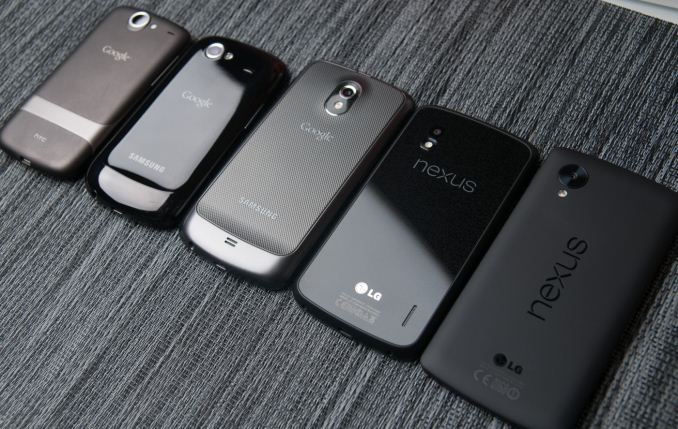
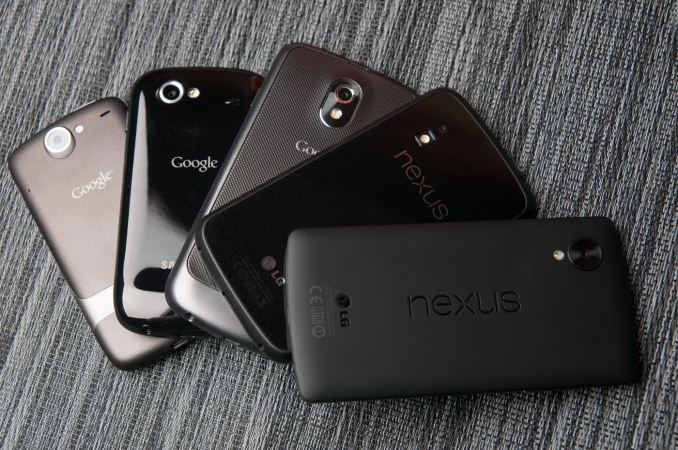
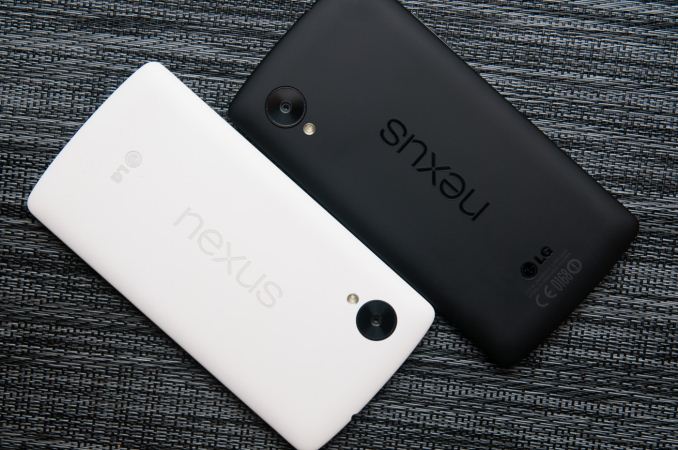
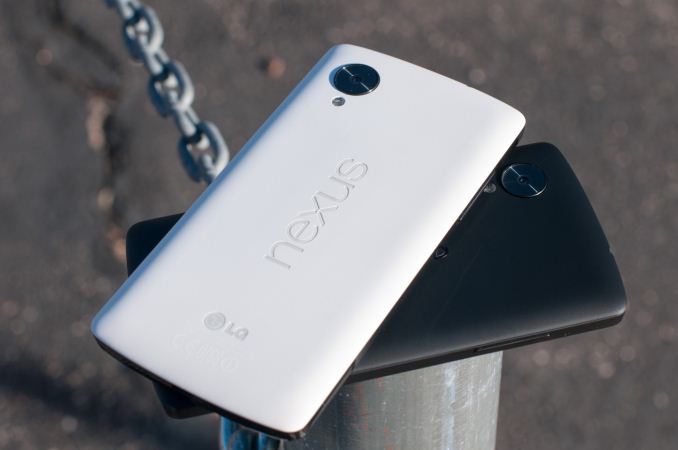
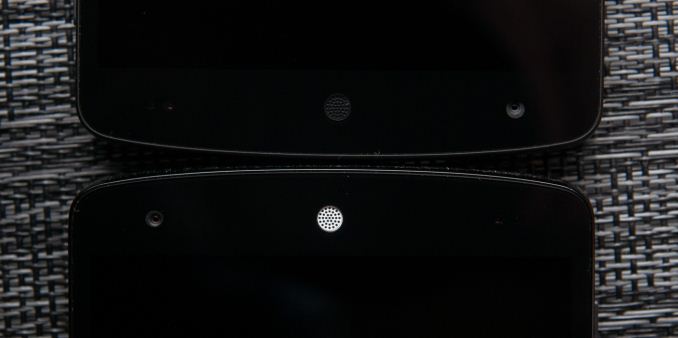
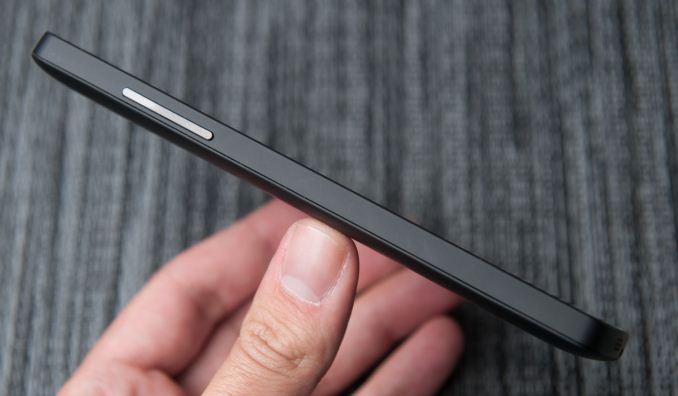
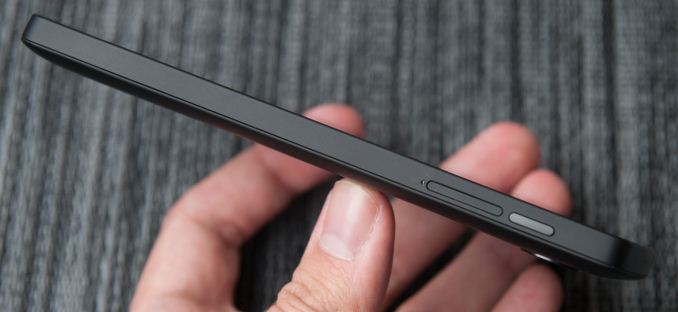








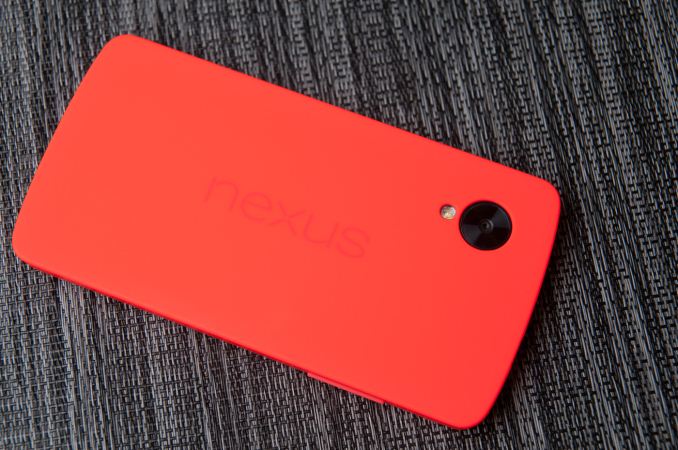
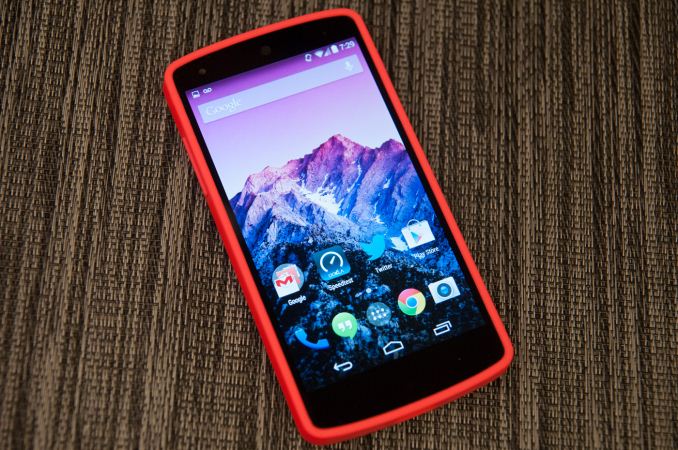








231 Comments
View All Comments
Azurael - Saturday, December 7, 2013 - link
On the other hand, I don't think you could say Android hasn't matured fantastically over the years. I've been a fan since the start (G1 > Desire > Desire Z > Atrix > SGS2 > One X > Nexus 4) These days, I look forward to using Android more than any other platform I interact with on a daily basis... Even 1.5 on the G1 felt like an upgrade from the busted original iPhone it replaced (maybe not graphically, but certainly functionally - Notifications and Copy/Paste!) And I really wouldn't want to use anything pre-ICS these days.And not being a fan of wine, I'd take an Android device any day over the offer of a glass of super priceless vintage wine :)
blackmagnum - Thursday, December 5, 2013 - link
When will Google owned Motorola get a chance to build a Nexus? I'll be looking for a different design language than the Koreans.mrdude - Thursday, December 5, 2013 - link
Never, I hope.The Moto X has some really innovative ideas that are unlike any other phone in the market. I think that phone showed that Motorola is aware that there's a lot more to a great smartphone than just bumping up specs and PPI. The Nexus line, at least to me, seems to be about providing a stable platform to push out Android releases and offer a clean and conservative platform to build upon or strive for. A Moto version of Nexus would likely be just another boring smartphone, which is what I find most Nexus phones to be - great phones, sure, but really boring :P
Thanks for the review, Brian. Looks like I'm pulling the trigger on the Moto X for roughly the same price
usama_ah - Thursday, December 5, 2013 - link
Completely agree. For a while I wanted a Motorola Nexus but after the Moto X I am happy with Motorola doing their own thing because they've been doing a great job. If anything it would be nice if the two camps (Moto and the Nexus team) learned from each other.Wolfpup - Thursday, December 5, 2013 - link
I'm fine with the Moto X *IF* it's supported roughly as fast and long as the Nexus line. I figure the Moto X might be, as it might sort of be an unofficial Nexus, given it's supposed to be pretty clean android, and is technically FROM Google.I wouldn't touch anything else with a 10 foot pole. Gross 3rd party goop on top of the OS, and if you're lucky you get one OS update, and then it's 8 months late (but hey, that's okay, malware writers are good about waiting for everyone to update before they attack, it's just good sportsmanship).
The goop Samsung and the rest slop on top of Android reminds me of the bad old Windows 3.1 days, although with Windows 3.1 at least some of the ideas there were interesting, and you could revert to the real interface.
Pr3ch34r - Thursday, December 5, 2013 - link
As long as the nexus line, is that a joke? I just sold a less than 2 years hold Galaxy Nexus that won't even see 4.4, even Samsung devices last more wrt upgrades...Pr3ch34r - Thursday, December 5, 2013 - link
Hold = old, pls excuse this keyboardElrando Horse - Friday, December 6, 2013 - link
Please point me towards the 2011 Samsung phone getting the Kitkat upgrade.redundant - Friday, December 6, 2013 - link
the beauty of the nexus line is how damn easy it is to install a custom ROM with 4.4. i know that the average user wouldnt be interested in installing a custom rom, but then again nexus buyers usually arent your average folk.Azurael - Saturday, December 7, 2013 - link
Erm, since the design language is from Google, I'm not quite sure what you're hoping for... Does the Nexus 5 look like the G2? No, it doesn't. Does the Galaxy Nexus look like the SGS2/3? No. The Nexus 4 looks more like the Optimus G than the others I've mentioned with it's sparkly glass back, but it's still more Google than LG given the hardware platform is the same! What have you got against Korean design anyway? It's not like anything Motorla have produced since the original RAZRs could be regarded as stylistically interesting... All smartphones look pretty much the same, it's just something we're going to have to grow to live with. A big slab of glass with a speaker at the top and a mic at the bottom is just that, and you can't really deviate too far without hampering ergonomics.